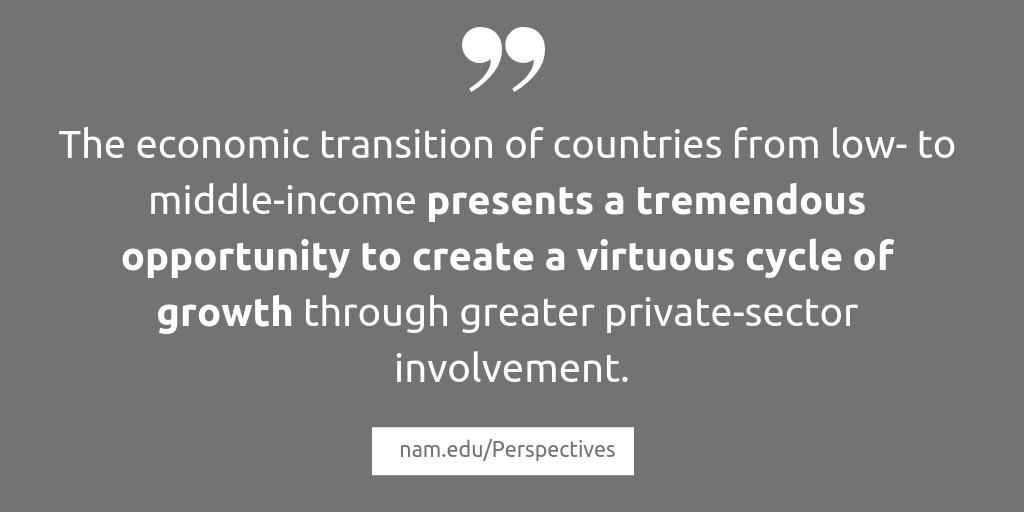The Evolving Case for Public-Private Partnerships to Achieve the Global Goals

Upon arriving in Kenya in 1987, I was a well-trained parasitologist who knew nothing about development, economics, political systems, or structural poverty. Kenya, however, became my classroom. The focus three decades ago was to attack one disease at a time, to engage in heavily lopsided partnerships financed with public money, and to ignore, if not outright denigrate, the role of the private sector. Over the 14 years that I lived and worked in Kenya, I observed that the paradigm of “public assistance” from high-income to low-income countries, in most cases, did not yield the desired results—that is, significant improvements in health systems and economic self-reliance. Today, as a global health educator, I have come to firmly believe that the principles of equity and justice embodied in global health can lead to a more productive paradigm only if we include the private sector.
This perspective has been reinforced given the imminent economic and programmatic transitions in global health. Economic transitions are occurring when countries move from low- to middle-income status (e.g., India and Nigeria) and may no longer meet the criteria for funding established by the donor agency. Programmatic transitions are the result of an initiative achieving its goal (e.g., Global Polio Eradication Initiative) [1]. In both scenarios, countries that have traditionally relied on development assistance for health (DAH) will experience a contraction of financing from bilateral and multilateral sources.
There are many potentially harmful impacts of these transitions if they are not properly planned, coordinated, and managed, particularly at the country level. These impacts include a reversal of significant gains in health achieved over the past 15 years. The most vulnerable populations will absorb the brunt of the impact. While many donor organizations are well aware of the potential impacts and are carefully trying to ease transitions, the immense challenge and complexity of proper planning, coordination, and management is an ongoing theme. One question rises to the top: what role can public-private partnerships play in the solution?
This question sparked an epiphany for me. Countries that find their DAH shrinking due to their expanding economies present an opportunity for the private sector to partner with government and civil society.
The private sector can be defined broadly to include industries and sectors that 1) are directly health-related and make a direct contribution to the health system through their products and services or 2) are not health related. The broad definition of “contribution” includes financial inputs as well as products, services, technology, skills, expertise, and systems thinking. Private-sector engagement has the potential to contribute directly to health systems development by providing products, services, technology, and expertise. Increased employment in the formal economy may lead to health benefits through workplace health promotion programs, including occupational health; direct provision of health services in on-site clinics or contracted facilities; and affordable health insurance options. Increased private-sector investment has the potential to expand tax revenues, thus improving the countries’ ability to provide social services to disproportionately affected communities.
As low-income nations’ economies and infrastructures improve, they become less attractive candidates for public assistance and more attractive candidates for private-sector engagement and investment. Business risks lower as supportive systems—e.g., education systems, health systems, a skilled workforce, financial systems, and rule of law—are established. Countries that are transitioning out of DAH will reap the rewards of partnering with the private sector to maintain and improve the essential systems that lead to a robust, attractive business environment. These countries will position themselves to benefit from the engagement of multinational corporations and, more importantly, will encourage homegrown innovation and entrepreneurialism.
It is my observation that the global health enterprise often considers health delivery services as the single most important intervention, while frequently freezing its gaze on the public sector for solutions. Ultimately, the importance of the social determinants of health and the added value of the private sector to positively impact these determinants—as well as to provide more direct health services—are ignored.
Global health leaders and organizations are frequently suspicious of the private sector’s motivations. I confess to my own tendency to distrust the private sector and doubt its ability to make significant contributions to public health in a manner free from pure profit motivation. I have learned that this thinking is flawed. It views health in a silo and not as part of a system that is shaped by politics, law, environment, culture, and history.
What global health–public financing purists fail to recognize is that the Global Goals (UN Sustainable Development Goals) [2] are interdependent and cannot possibly be achieved by the public sector alone. I recognized the necessity of broad private-sector engagement—to contribute both financial and technical resources across all of the Global Goals—once I stopped thinking of the global health enterprise in a silo. The economic transition of countries from low- to middle-income presents a tremendous opportunity to create a virtuous cycle of growth through greater private-sector involvement. This cycle, however, depends wholly on both the public and private sectors agreeing to work toward the Global Goals and leading with both people- and environment-centered values and principles.
As I searched for examples of private-sector accountability, I discovered the Business and Sustainable Development Commission, launched in Davos in 2016. The commission brings together leaders from business, finance, civil society, labor, and international organizations. It models economic opportunities and business gains related to achieving the Global Goals and investigates how business can contribute to achieving the goals. The commission’s report Better Business, Better World argues the business world must “embrace an economic model which is not only low-carbon and environmentally sustainable, but also turns poverty, inequality and lack of financial access into new market opportunities for smart, progressive, profit-oriented companies” [3]. It further states that the report “argues that sustainable business models could open economic opportunities worth up to $12 trillion and increase employment in the developing world by up to 380 million jobs by 2030.” The commission’s report presents convincing data to show that companies that embrace principles of the Global Goals will be more profitable and sustainable. Optimism that businesses can be held to corporate responsibility standards is supported by increasing demands from civil societies’ citizens that companies adhere to certain codes of responsibility. The report also shows that businesses that intentionally choose the path of social responsibility are at least equally profitable.
The public sector must also act responsibly and transparently, with accountability to their stakeholders. Civil society is increasingly distrustful due to corruption, inefficiencies, misdirection of priorities, misuse of power, and other practices undermining public confidence. This is true of the global public sector (e.g., bilateral aid, multilateral aid), national governments, and regional authorities.
Finally, the United Nations identified “six essential elements for delivering the Global Goals” [2]:
-
- Dignity – to end poverty and fight inequalities
- Prosperity – to grow a strong, inclusive and transformative economy
- Justice – to promote safe and peaceful societies and strong institutions
- Partnership – to catalyze global solidarity for sustainable development
- Planet – to protect our ecosystems for all societies and our children
- People – to ensure healthy lives, knowledge, and the inclusion of women and children
A framework to guide the process of developing health-focused public-private partnerships based on the priorities defined by countries’ national plans for sustainable development was recently proposed [4]. The global health community should invest in establishing these elements as a framework for public and private-sector engagement. The global health community should actively assist transitioning countries in establishing accountability for the public and private sectors to contribute ethically, sustainably, and productively to the Global Goals. As a global health educator, I intend to share this framework and future vision with my students.
Join the conversation!
![]() Tweet this! As we look to support global health and health equity for all, we must consider the private sector as an important partner in this process: https://doi.org/10.31478/201810c #NAMPerspectives
Tweet this! As we look to support global health and health equity for all, we must consider the private sector as an important partner in this process: https://doi.org/10.31478/201810c #NAMPerspectives
![]() Tweet this! Global health has traditionally been supported by the public sector. However, as countries grow out of assistance requirements, the private sector can play a critical role in ensuring continued growth: https://doi.org/10.31478/201810c #NAMPerspectives
Tweet this! Global health has traditionally been supported by the public sector. However, as countries grow out of assistance requirements, the private sector can play a critical role in ensuring continued growth: https://doi.org/10.31478/201810c #NAMPerspectives
![]() Tweet this! Our newest #NAMPerspectives Commentary notes that global health cannot be viewed in a silo, and continued progress requires a broadening of financial and technical resources: https://doi.org/10.31478/201810c
Tweet this! Our newest #NAMPerspectives Commentary notes that global health cannot be viewed in a silo, and continued progress requires a broadening of financial and technical resources: https://doi.org/10.31478/201810c
Download the graphics below and share them on social media!


References
- ACTION Global Health Advocacy Partnership. 2017. Progress in peril? The changing landscape of global health financing. London, UK: RESULTS Educational Fund. Available at: https://www.results.org.uk/publications/progress-peril-changing-landscape-global-health-financing (accessed September 14, 2018).
- United Nations, General Assembly. 2014. A/69/700 — The road to dignity by 2030: Ending poverty, transforming all lives and protecting the planet. Available at: https://sustainabledevelopment.un.org/index.php?page=view&type=111&nr=6179&menu=35 (accessed September 14, 2018).
- Business and Sustainable Development Commission. 2017. Better business, better world. Available at: http://report.businesscommission.org/reports (accessed September 14, 2018).
- Boufford, J., R. Gadde, C. Acemah, G. Alleyne, S. Bland, and B. Colatrella. 2017. A proposed framework for developing health-focused public-private partnerships based on national Sustainable Development Priorities. NAM Perspectives. Discussion Paper, National Academy of Medicine, Washington, DC. https://doi.org/10.31478/201707d
